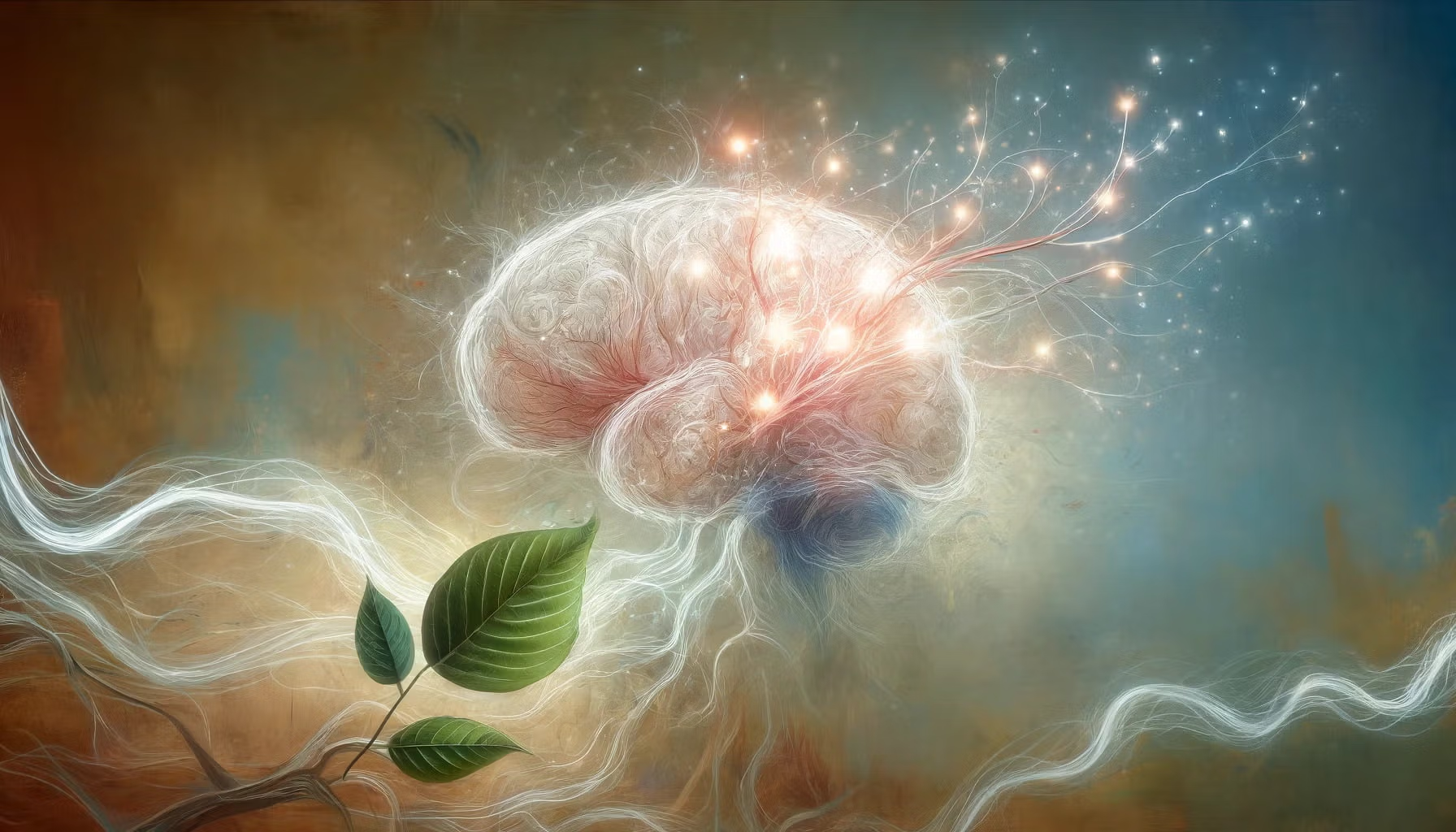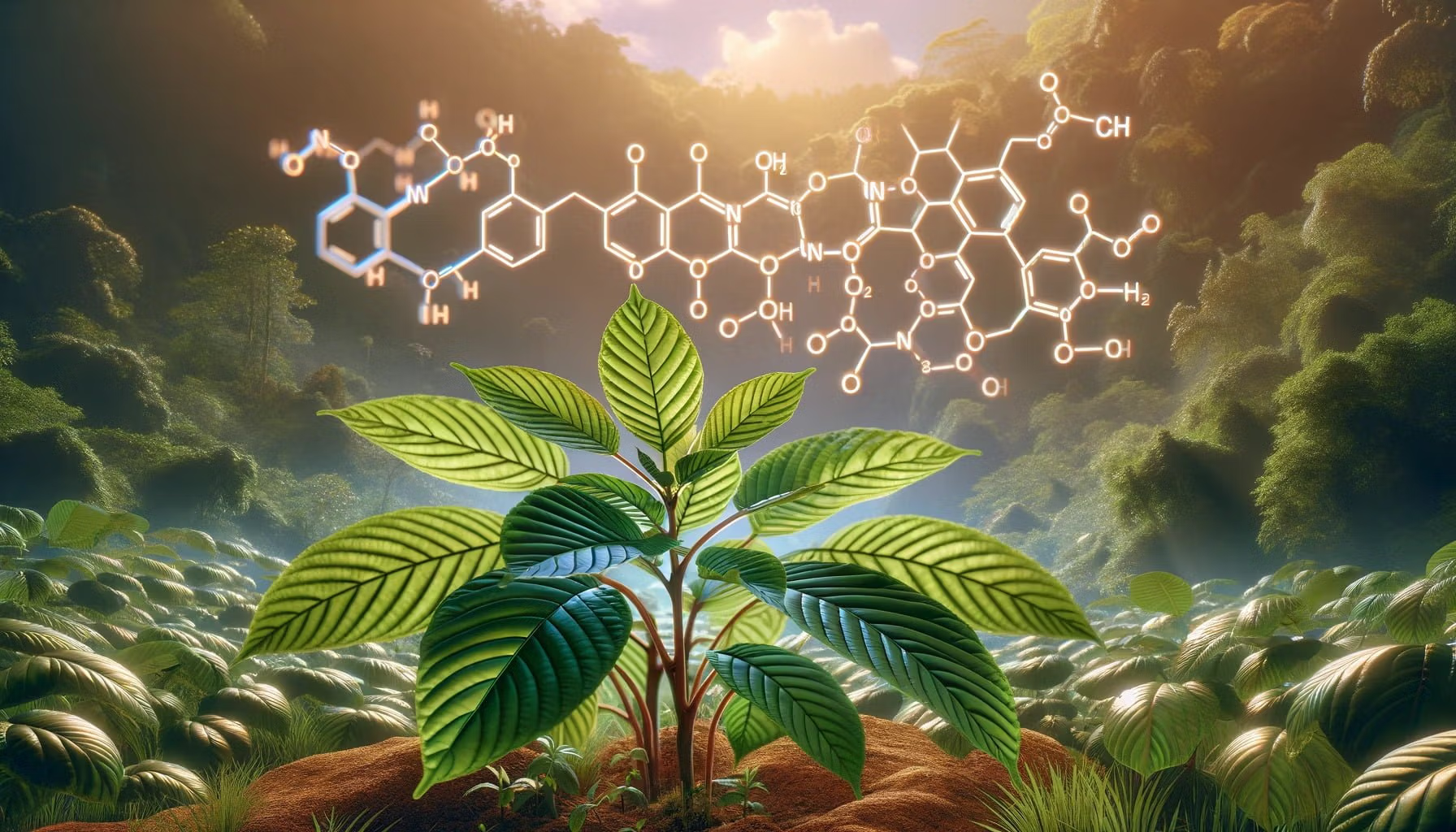
Kratom (Mitragyna speciosa) serves as a natural nootropic supplement derived from a tree in the coffee family native to Southeast Asia. Kratom contains over 40 alkaloids, with mitragynine comprising about 66% of the total alkaloid content, which interact with mu, delta, and kappa opioid receptors in the brain.
Kratom offers cognitive benefits through multiple mechanisms of action, primarily affecting opioid receptors and neurotransmitter systems including serotonergic, dopaminergic, and adrenergic pathways. Kratom enhances mental performance at low doses (1-3 grams) by increasing energy, focus, attention span, and memory while reducing anxiety.
Kratom differs from classical nootropics due to its dose-dependent effects, becoming more sedative at higher doses and carrying potential for dependence. Kratom remains federally legal in the United States but faces bans in several states, requiring users to verify local regulations before purchase or consumption.
Table of Contents
What is Kratom?
Kratom (also known as Mitragynine, Thang, Kakuam, and Mambog) is a tree in the coffee family (Rubiaceae) indigenous to Thailand, Malaysia, Indonesia, and Papua New Guinea.

The leaves of the kratom tree have been used for centuries in traditional medicine to relieve pain, boost energy and mood, and treat various ailments such as diarrhea, diabetes, and high blood pressure.
In recent years, kratom has gained attention as a potential nootropic supplement for enhancing cognitive function and productivity.
Is Kratom Considered a Nootropic?
Kratom functions as a nootropic substance that enhances cognitive performance through its interaction with brain receptors, although it differs from classical nootropics in several ways. By definition, nootropics are substances that improve cognitive function, particularly executive functions, memory, creativity, or motivation, in healthy individuals.
Kratom meets several criteria for nootropic classification:
- It enhances mental performance and cognitive function at low doses
- It improves attention, focus, and mental stamina
- It positively affects mood and reduces anxiety, which indirectly supports cognitive function
- It provides neuroprotective effects through its antioxidant properties
However, unlike some classical nootropics like racetams or modafinil, kratom has dose-dependent effects that can become sedative rather than stimulating at higher doses. Additionally, its potential for dependence and withdrawal sets it apart from “true nootropics” that typically have minimal side effects.
Many users consider kratom a functional nootropic, particularly when used at low doses (1-3 grams) where the stimulant and focus-enhancing effects predominate over the sedative properties found at higher doses.
What Are The Bioactive Compounds in Kratom?
The primary bioactive compounds in kratom leaves are alkaloids, including mitragynine, 7-hydroxy mitragynine, and over 40 other identified alkaloids.
Mitragynine makes up about 66% of the total alkaloid content.
These alkaloids interact with mu, delta, and kappa opioid receptors in the brain, producing effects similar to opioids like morphine.
Other notable compounds in kratom include:
- Speciogynine
- Speciociliatine
- Paynantheine
- Rhynchophylline
- Mitraphyllin
What Are The Nootropic Uses of Kratom?
Many people use kratom as a natural alternative to prescription stimulants like Adderall or Ritalin for managing symptoms of ADHD or improving productivity.
At higher doses, kratom produces more opioid-like effects such as pain relief, relaxation, and sedation.
According to a survey, the most common reasons people use kratom are:
- Increased energy (79%)
- Decreased pain (67%)
- Increased focus (66%)
- Less anxiety (65%)
- Elevated mood (54%)
What are Kratom’s Mechanisms of Action?
Kratom functions as a nootropic through multiple mechanisms of action that primarily involve the mu-opioid receptors (MOR) and alpha-2 adrenergic receptors in the brain, which directly influence cognitive processing and mental performance.
Mitragynine and 7-hydroxy mitragynine are partial agonists of the MOR, producing opioid-like effects.
However, unlike classical opioids, these alkaloids are biased agonists, preferentially activating G protein signaling over β-arrestin-2 recruitment.
This results in a lower risk of respiratory depression and other dangerous side effects associated with traditional opioids.
Mitragynine also interacts with other neurotransmitter systems:
- Serotonergic (5-HT2A and 5-HT7 receptors)
- Dopaminergic (D1 receptors)
- Adrenergic (α2 receptors)
The serotonergic and dopaminergic activity contributes to kratom’s mood-enhancing and stimulant effects.
Modulation of adrenergic signaling may play a role in its stimulant, analgesic, and anxiolytic properties.
How Bioavailible is Kratom?
Kratom has relatively low oral bioavailability (approx. 21%) due to extensive first-pass metabolism in the liver.(1)
The oral bioavailability of mitragynine in rats was only around 3%.
Pro Tip: Taking kratom on an empty stomach and with potentiators like turmeric or grapefruit juice may enhance absorption.
What Are The Cognitive Benefits of Kratom?
Research on the cognitive benefits of kratom is limited, but preclinical studies and user reports suggest several potential advantages:
- Increased energy and alertness
- Enhanced attention and concentration
- Improved working memory
- Mood enhancement and anxiety reduction
- Better social interactions and confidence
Note: More human research is needed to validate these cognitive benefits and determine the optimal dosage and preparation for nootropic use.
How Does Kratom Increase Mental Stamina and Alertness?
The alkaloids mitragynine and 7-hydroxy mitragynine in kratom stimulate adrenergic and serotonergic receptors, leading to the release of adrenaline, noradrenaline, and serotonin.(2)
This produces a burst of energy and alertness, offsetting fatigue and sharpening focus.
Kratom can increase mental stamina and alertness, helping you stay focused and productive for extended periods.
Kratom’s stimulant effects also come from its action on other neurotransmitters like dopamine and acetylcholine.
By increasing dopamine in the brain’s reward circuits, it can boost motivation and make tasks feel more engaging. Acetylcholine is important for arousal, learning, and memory.
How Does Kratom Enhance Attention Span?
Kratom may enhance attention span by modulating neurotransmitters involved in focus and concentration (norepinephrine, serotonin, and acetylcholine).(3)
These brain chemicals heighten arousal and alertness, making it easier to zero in on a task and filter out distractions.
Acetylcholine, in particular, is critical for selective and sustained attention. Drugs that increase acetylcholine signaling, like nicotine and some Alzheimer’s medications, are known to sharpen focus.
Animal studies suggest mitragynine, the major alkaloid in kratom, interacts with nicotinic acetylcholine receptors.
By stimulating the release of norepinephrine and serotonin, kratom can increase mental energy and stamina, helping you stay focused for longer periods without getting fatigued or distracted.
Many users say they can concentrate intensely for hours on kratom, making it ideal for long study or work sessions.
How Does Kratom Improve Memory?
By increasing acetylcholine, serotonin, and catecholamine signaling, kratom may strengthen neural connections and facilitate long-term potentiation – the persistent strengthening of synapses that underlies learning and memory.
Many users report better memory and faster recall when using kratom, especially for verbal information.
A clinical study showed that mitragynine improved memory consolidation and retrieval in mice, likely by stimulating adrenergic and dopamine D1 receptors in the hippocampus and amygdala – brain areas crucial for emotional memory formation.(4)
How Does Kratom Reduce Anxiety and Depression?
Kratom’s opioid-like alkaloids, mitragynine and 7-hydroxymitragynine, activate mu-opioid receptors in the brain, triggering the release of endorphins and enkephalins – the body’s natural “feel-good” chemicals.(5)
These endogenous opioids have calming, mood-boosting, and pain-relieving effects, helping you stay calm, focused, and mentally flexible.
Kratom also interacts with GABA, the brain’s main inhibitory neurotransmitter.
Low GABA activity is linked to anxiety and overstimulation. By enhancing GABA signaling, kratom may slow down neuronal firing and promote a state of calm relaxation.
The alkaloid mitragynine binds to GABA-A receptors and potentiates GABA’s inhibitory effects.(6)
Anxiety and stress are well known to impair cognitive functions like attention, memory, and problem-solving.
What Are The Potential Side Effects and Risks of Kratom?
While kratom is generally well-tolerated, it can cause side effects, especially at high doses or with frequent use. Common side effects include:
- Nausea and vomiting
- Constipation
- Dizziness and drowsiness
- Dry mouth
- Itching

More serious risks associated with heavy, long-term kratom use include:
- Dependence and addiction
- Withdrawal symptoms (anxiety, irritability, insomnia, runny nose, diarrhea)
- Liver toxicity (rare cases of hepatitis and liver failure reported)
- Interactions with medications and other substances
It’s crucial to obtain kratom from reputable sources and monitor intake to minimize risks.
Who Should Avoid Kratom?
Certain individuals should avoid using kratom due to heightened risks:
- Pregnant and breastfeeding women: Kratom’s safety during pregnancy is unknown, and alkaloids can transfer to breast milk.
- People with pre-existing liver conditions: Kratom has been linked to rare cases of liver toxicity.
- Individuals with mental health disorders: Kratom may exacerbate symptoms of anxiety, depression, and psychosis in susceptible individuals.
- Those taking opioid medications or with a history of opioid addiction: Kratom can potentiate the effects of opioids and increase the risk of overdose and addiction.
What Are The Potential Interactions Between Medication and Kratom?
Kratom can interact with several medications because of its effects on liver enzymes and opioid receptors.
Notable potential interactions include:
- Opioid pain medications (e.g., morphine, oxycodone): Increased risk of respiratory depression and overdose.
- Benzodiazepines (e.g., alprazolam, diazepam): Enhanced sedation and respiratory depression.
- Stimulants (e.g., amphetamines, modafinil): Unpredictable effects, potentially dangerous increases in heart rate and blood pressure.
- CYP450 substrates (many common medications): Kratom inhibits several CYP450 enzymes, which may increase serum levels and effects of these drugs.
- Alcohol: Mixing kratom and alcohol can lead to increased drowsiness, dizziness, and impaired coordination.
Always consult a healthcare professional before combining kratom with any medications or supplements.
How To Use Kratom as A Nootropic?
Kratom can be consumed as a nootropic supplement through various methods that affect onset and duration of cognitive benefits:
- Toss and wash (mixing powder with water and swallowing)
- Brewing into a tea
- Capsules
- Tinctures
Experts recommend rotating strains and taking regular breaks to prevent tolerance and maintain the nootropic benefits.
What is The Recommended Dosage for Kratom?
General guidelines for kratom powder are:
| Dose | Effects |
|---|---|
| 1-3 grams | Mild stimulation, increased focus, and energy |
| 3-5 grams | Moderate stimulation, enhanced mood, and sociability |
| 5-8 grams | Strong effects, pain relief, relaxation, euphoria |
| 8+ grams | Very strong effects, sedation, increased risk of side effects |
However, kratom dosage depends on individual factors such as weight, tolerance, and desired effects.
Some vital tips to keep in mind about using Kratom for cognitive enhancement:
- Starting dose: For nootropic use, start with a threshold to light dose (1-3 grams) and assess your reaction.
- Dosage safety: Do not exceed 5 grams in a single dose to minimize the risk of side effects.
- Potency: Less is often more with kratom, as higher doses tend to be more sedating than stimulating.
- Avoid using daily: Limit intake to no more than 3-4 times per week.
- Use a reputable product: Choose a high-quality, lab-tested kratom product from a reputable vendor.
- Cycling: Cycle kratom use to prevent tolerance and dependence (e.g., 2-3 days on, 2-3 days off).
- Drink water: Stay hydrated and monitor for any adverse effects.
Can Kratom Be Used in A Nootropic Stack?
Yes, kratom can be incorporated into a nootropic stack with other supplements for synergistic cognitive benefits that enhance its focus-promoting properties while potentially reducing side effects.
Nootropics that may complement kratom include:
- Caffeine: Enhances the stimulant and focus-promoting effects of low-dose kratom.
- L-theanine: Smooths out the stimulation and reduces jitteriness.
- Rhodiola rosea: Supports mood and resilience to stress.
- Bacopa monnieri: Enhances memory and reduces anxiety.
Start with low doses of each substance and monitor your response before gradually increasing.
What Are the Pros and Cons of Using Kratom for Cognitive Enhancement?
Kratom shows promise as a natural nootropic for boosting energy, focus, and mood. However, its use carries risks, particularly with high doses and frequent intake.

Let’s take a closer look at this natural nootropic’s risks and benefits.
| Pros | Cons |
|---|---|
| Increased energy, focus, and motivation at low doses | Addictive potential with frequent, high-dose use |
| Mood enhancement and anxiety reduction | Risk of dependence, withdrawal, and side effects |
| Potential memory and attention benefits | Lack of regulation and quality control in the kratom market |
| Natural alternative to prescription stimulants | Limited research on long-term safety and cognitive effects |
| Relatively safe when used responsibly in moderation | The legal status of kratom varies by country and state |
Kratom differs from other nootropics for cognitive enhancement because it provides both stimulant and relaxant effects depending on dosage, whereas substances like racetams enhance memory without sedation and modafinil promotes wakefulness without opioid-like effects. Kratom offers a unique balance of focus enhancement and anxiety reduction that many synthetic nootropics cannot provide, though it carries more significant dependence potential than compounds like L-theanine or bacopa monnieri.
What Do Users of Kratom Say?
Here are some quotes from kratom users about their experiences:
- “Kratom has helped me stay focused and productive at work without the jitters and crashes I got from coffee.” – John, 32
- “As someone with social anxiety, kratom has made it easier for me to interact with others and feel more confident in social situations.” – Sarah, 28
- “Kratom is my go-to when I need to buckle down and power through mentally taxing projects. It increases my mental stamina and I can concentrate deeply for a long time without burning out.” – Jen, 32
- “I’ve been using kratom for chronic pain management and have noticed a significant improvement in my cognitive function and overall well-being.” – Michael, 45
Of course, individual results may vary and these anecdotes don’t substitute for controlled clinical research.
However, many users are convinced kratom enhances their brainpower in noticeable ways.
Is Kratom Legal to Use?
In the United States, kratom is legal at the federal level but banned or regulated in some states, including Alabama, Arkansas, Indiana, Rhode Island, Vermont, and Wisconsin.
It’s important to check your local laws before purchasing or using kratom.
- Ya, Kimheang et al. “Pharmacokinetics of mitragynine, a major analgesic alkaloid in kratom (Mitragyna speciosa): A systematic review.” Asian journal of psychiatry vol. 43 (2019): 73-82. doi:10.1016/j.ajp.2019.05.016↩
- León, Francisco et al. “Activity of Mitragyna speciosa (“Kratom”) Alkaloids at Serotonin Receptors.” Journal of medicinal chemistry vol. 64,18 (2021): 13510-13523. doi:10.1021/acs.jmedchem.1c00726↩
- McCurdy, Christopher R et al. “An update on the clinical pharmacology of kratom: uses, abuse potential, and future considerations.” Expert review of clinical pharmacology vol. 17,2 (2024): 131-142. doi:10.1080/17512433.2024.2305798↩
- Yunusa, Suleiman et al. “Mitragynine inhibits hippocampus neuroplasticity and its molecular mechanism.” Pharmacological reports : PR vol. 75,6 (2023): 1488-1501. doi:10.1007/s43440-023-00541-w↩
- Johnson, Lindsay E et al. “The Potential for Kratom as an Antidepressant and Antipsychotic.” The Yale journal of biology and medicine vol. 93,2 283-289. 29 Jun. 2020↩
- Effendy, Mohamad Azmeer et al. “The role of AMPA and NMDA receptors in mitragynine effects on hippocampal synaptic plasticity.” Behavioural brain research vol. 438 (2023): 114169. doi:10.1016/j.bbr.2022.114169↩

